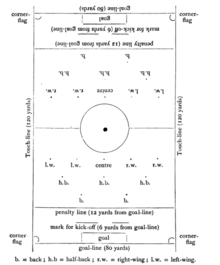Thepenalty areaor18-yard box(also known less formally as thepenalty boxor simplybox) is an area of anassociation football pitch.It is rectangular and extends 18 yd (16 m) to each side of the goal and 18 yd (16 m) in front of it. If any part of the ball is over any part of a line demarking the penalty area then the ball is considered to be inside the penalty area.



Within the penalty area is the penalty spot, which is 12 yd (11 m) from the goal line, directly in line with the centre of the goal.
A penalty arc (often informally called "the D" ) adjoins the penalty area, and encloses the area within 10 yd (9.1 m) of the penalty spot. It does not form part of the penalty area and is only of relevance during the taking of apenalty kick,when any players inside the arc are adjudged to be encroaching.[1]
Within the penalty area is another smaller rectangular area called thegoal area(colloquially the"six-yard box"), which is delimited by two lines starting on the goal-line 6 yd (5.5 m) from the goalposts and extending 6 yd (5.5 m) into the pitch from the goal-line, and the line joining these. Goal kicks and any free kick by the defending team may be taken from anywhere in this area. Indirect free kicks awarded to the attacking team within the goal area are taken from the point on the line parallel to the goal line (the "six-yard line" ) nearest where the infringement occurred; they cannot be taken any closer to the goal line. Similarlydrop-ballsthat would otherwise occur closer to the goal line are taken on this line.
Previously, penalty areas extended across the full width of the field; they were reduced to their current dimensions in 1901.[2]
Functions
editFouls punishable by adirect free kick(i.e. handling the ball and most physical fouls), committed by the defensive team within the penalty area, may be penalised by a penalty kick.[3]A penalty kick is taken from the penalty spot. The penalty spot is located 12 yards (11 m) away from the goal line.
The penalty area has other functions, including:
- Goalkeepers:The area delimiting the area in which a goalkeeper may legally handle the ball;
- Goal kicksand defensivefree kicks:opponents must remain outside of the area and at least 10 yards away from the ball until the ball is kicked and clearly moves;
- Taking of penalty kicks: players other than the kicker and the goalkeeper must remain outside the area (and also the penalty arc) until the kick has been taken.
In play
editIn a typical game, for the majority of time the penalty area is occupied only by the goalkeeper. The attacking team generally aims to get the ball and their own players into the defending team's penalty area, and a high percentage of goals in professional football are scored from within the penalty area.[4]Usually during attackingset pieces,includingcorners,a large number of both attacking and defending players are in the penalty area and, although illegal, grappling between players is frequently observed.[5]
References
edit- ^"Laws of the Game 2017-2018"(PDF).FIFA.p. 36.Archived(PDF)from the original on 12 July 2021.
- ^"The Origins Of Football Pitch Markings".football-stadiums.co.uk.22 March 2018.
- ^"LAW 12: FOULS AND MISCONDUCT".The FA.Retrieved28 October2014.
- ^Mitrotasios, Michalis; Armatas, Vasilis (16 January 2014)."Analysis of Goal Scoring Patterns in the 2012 European Football Championship".The Sport Journal.United States Sports Academy.Retrieved28 October2014.
Other research has examined the position on the pitch from which goals are scored. In a recent study Wright et al. (50) showed that from 167 goals from English Premier League, 87% of goals were scored inside the penalty area which is similar to the 90% observed by Olsen (36) for the 1986 World Cup whereas Dufour (14) reported 80% for the 1990 World Cup. Yiannakos and Armatas (51) reported that 44.4% of goals scored were inside the penalty area, 35.2% inside the goal area, and 20.4% outside the penalty area, for the 2004 European Championship in Portugal. Finally, Hughes et al. (22) showed that successful teams in the 1986 Football World Cup made more attempts inside the penalty area in comparison to unsuccessful teams.
- ^Singh, Amit (27 October 2014)."Should referees take a tougher stance on penalty box holding at set-pieces?".Think Football.Retrieved28 October2014.